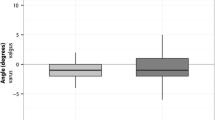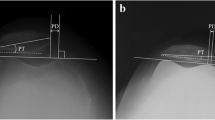Abstract
Background
Since the medial parapatellar (MPP) approach in conventional TKA can cause patellar maltracking and anterior knee pain, some orthopaedic surgeons use the midvastus (MV) approach instead of the MPP approach to reduce patellar maltracking. Minimally invasive surgical (MIS) TKA has been developed to limit the damage to the surrounding muscle and reduce the necessity of patellar eversion during surgery. Thus, MIS TKA might be associated with proper patellar tracking and a low incidence of anterior knee pain. However, this presumption has not been confirmed.
Questions/purposes
We asked whether the incidence of patellar maltracking and anterior knee pain differed with the MV and MPP in association with MIS TKA.
Methods
We prospectively followed 59 patients (60 knees) treated with 60 primary cemented MIS TKAs from August 2009 to September 2010. We randomized the patients into two groups: 30 who had a limited MPP approach and 30 who had a mini-MV approach. We recorded the occurrence of anterior knee pain, patellar tilting, and subluxation. The minimum followup was 12 months (mean, 18.03 months; range, 12.00–25.08 months).
Results
We found no differences in anterior knee pain (two of 30, 7% versus two of 30, 7%), mean patellar tilt (3.4º ± 2.9º versus 3.0 ± 2.3º), and mean patellar subluxation (1.5 ± 1.1 mm versus 1.1 ± 0.7 mm) between the limited MPP and mini-MV groups, respectively.
Conclusions
MIS TKA using either the MPP or MV approach has a low incidence of patellar maltracking and anterior knee pain.
Level of Evidence
Level I, therapeutic study. See the Guidelines for Authors for a complete description of the levels of evidence.
Similar content being viewed by others
References
Archibeck MJ, Camarata D, Trauger J, Allman J, White RE Jr. Indications for lateral retinacular release in total knee replacement. Clin Orthop Relat Res. 2003;414:157–161.
Baldini A, Anderson JA, Cerulli-Mariani P, Kalyvas J, Pavlov H, Sculco TP. Patellofemoral evaluation after total knee arthroplasty: validation of a new weight-bearing axial radiographic view. J Bone Joint Surg Am. 2007;89:1810–1817.
Barrack RL, Schrader T, Bertot AJ, Wolfe MW, Myers L. Component rotation and anterior knee pain after total knee arthroplasty. Clin Orthop Relat Res. 2001;392:46–55.
Bonutti PM, Mont MA, McMahon M, Ragland PS, Kester M. Minimally invasive total knee arthroplasty. J Bone Joint Surg Am. 2004;86(suppl 2):26–32.
Burnett RS, Boone JL, Rosenzweig SD, Steger-May K, Barrack RL. Patellar resurfacing compared with nonresurfacing in total knee arthroplasty: a concise follow-up of a randomized trial. J Bone Joint Surg Am. 2009;91:2562–2567.
Chotanaphuti T, Ongnamthip P, Karnchanalerk K, Udombuathong P. Comparative study between 2 cm limited quadriceps exposure minimal invasive surgery and conventional total knee arthroplasty in quadriceps function: prospective randomized controlled trial. J Med Assoc Thai. 2008;91:203–207.
Daluga D, Lombardi AV Jr, Mallory TH, Vaughn BK. Knee manipulation following total knee arthroplasty: analysis of prognostic variables. J Arthroplasty. 1991;6:119–128.
Dalury DF, Jiranek WA. A comparison of the midvastus and paramedian approaches for total knee arthroplasty. J Arthroplasty. 1999;14:33–37.
Engh GA, Parks NL, Ammeen DJ. Influence of surgical approach on lateral retinacular releases in total knee arthroplasty. Clin Orthop Relat Res. 1996;331:56–63.
Figgie HE 3rd, Goldberg VM, Heiple KG, Moller HS 3rd, Gordon NH. The influence of tibial-patellofemoral location on function of the knee in patients with the posterior stabilized condylar knee prosthesis. J Bone Joint Surg Am. 1986;68:1035–1040.
Gomes LS, Bechtold JE, Gustilo RB. Patellar prosthesis positioning in total knee arthroplasty: a roentgenographic study. Clin Orthop Relat Res. 1988;236:72–81.
Insall JN, Dorr LD, Scott RD, Scott WN. Rationale of the Knee Society clinical rating system. Clin Orthop Relat Res.1989;248:13–14.
Laskin RS. Lateral release rates after total knee arthroplasty. Clin Orthop Relat Res. 2001;392:88–93.
Laskin RS, Beksac B, Phongjunakorn A, Pittors K, Davis J, Shim JC, Pavlov H, Petersen M. Minimally invasive total knee replacement through a mini-midvastus incision: an outcome study. Clin Orthop Relat Res. 2004;428:74–81.
Laughlin RT, Werries BA, Verhulst SJ, Hayes JM. Patellar tilt in total knee arthroplasty. Am J Orthop (Belle Mead NJ). 1996;25:300–304.
Lombardi AV Jr, Berend KR, Mallory TH, Dodds KL, Adam JB. Soft tissue and intra-articular injection of bupivacaine, epinephrine, and morphine has a beneficial effect after total knee arthroplasty. Clin Orthop Relat Res. 2004;428:125–130.
Maestro A, Suarez MA, Rodriguez L, Guerra C, Murcia A. The midvastus surgical approach in total knee arthroplasty. Int Orthop. 2000;24:104–107.
Mauerhan DR, Mokris JG, Ly A, Kiebzak GM. Relationship between length of stay and manipulation rate after total knee arthroplasty. J Arthroplasty. 1998;13:896–900.
Meftah M, Jhurani A, Bhat JA, Ranawat AS, Ranawat CS. The effect of patellar replacement technique on patellofemoral complications and anterior knee pain. J Arthroplasty. 2012;27:1075–1080.e1.
Miyagi T, Matsuda S, Miura H, Nagamine R, Urabe K, Inoue S, Iwamoto Y. Changes in patellar tracking after total knee arthroplasty: 10-year followup of Miller-Galante I knees. Orthopedics. 2002;25:811–813.
Namba RS, Inacio M. Early and late manipulation improve flexion after total knee arthroplasty. J Arthroplasty. 2007;22(6 suppl 2):58–61.
Ozkoc G, Hersekli MA, Akpinar S, Ozalay M, Uysal M, Cesur N, Tandogan RN. Time dependent changes in patellar tracking with medial parapatellar and midvastus approaches. Knee Surg Sports Traumatol Arthrosc. 2005;13:654–657.
Pollock DC, Ammeen DJ, Engh GA. Synovial entrapment: a complication of posterior stabilized total knee arthroplasty. J Bone Joint Surg Am. 2002;84:2174–2178.
Rader CP, Lohr J, Wittmann R, Eulert J. Results of total knee arthroplasty with a metal-backed patellar component: a 6-year follow-up study. J Arthroplasty. 1996;11:923–930.
Scranton PE Jr. Management of knee pain and stiffness after total knee arthroplasty. J Arthroplasty. 2001;16:428–435.
Sneppen O, Gudmundsson GH, Bunger C. Patellofemoral function in total condylar knee arthroplasty. Int Orthop. 1985;9:65–68.
Tanavalee A, Thiengwittayaporn S, Itiravivong P. Progressive quadriceps incision during minimally invasive surgery for total knee arthroplasty: the effect on early postoperative ambulation. J Arthroplasty. 2007;22:1013–1018.
Tria AJ Jr, Coon TM. Minimal incision total knee arthroplasty: early experience. Clin Orthop Relat Res. 2003;416:185–190.
Vendittoli PA, Makinen P, Drolet P, Lavigne M, Fallaha M, Guertin MC, Varin F. A multimodal analgesia protocol for total knee arthroplasty: a randomized controlled study. J Bone Joint Surg Am. 2006;88:282–289.
Waters TS, Bentley G. Patellar resurfacing in total knee arthroplasty: a prospective, randomized study. J Bone Joint Surg Am. 2003;85:212–217.
White RE Jr, Allman JK, Trauger JA, Dales BH. Clinical comparison of the midvastus and medial parapatellar surgical approaches. Clin Orthop Relat Res. 1999;367:117–122.
Wood DJ, Smith AJ, Collopy D, White B, Brankov B, Bulsara MK. Patellar resurfacing in total knee arthroplasty: a prospective randomized trial. J Bone Joint Surg Am. 2002;84:187–193.
Yang CC, McFadden LA, Dennis DA, Kim RH, Sharma A. Lateral retinacular release rates in mobile- versus fixed-bearing TKA. Clin Orthop Relat Res. 2008;466:2656–2661.
Yercan HS, Sugun TS, Bussiere C, Ait Si Selmi T, Davies A, Neyret P. Stiffness after total knee arthroplasty: prevalence, management and outcomes. Knee. 2006;13:111–117.
Acknowledgments
We thank Paskorn Sritipsukho MD, Department of Clinical Research, Faculty of Medicine, Thammasat University Thailand, for statistical consultation.
Author information
Authors and Affiliations
Corresponding author
Additional information
Each author certifies that he or she, or a member of his or her immediate family, has no funding or commercial associations (eg, consultancies, stock ownership, equity interest, patent/licensing arrangements, etc) that might pose a conflict of interest in connection with the submitted article.
All ICMJE Conflict of Interest Forms for authors and Clinical Orthopaedics and Related Research editors and board members are on file with the publication and can be viewed on request.
Clinical Orthopaedics and Related Research neither advocates nor endorses the use of any treatment, drug, or device. Readers are encouraged to always seek additional information, including FDA approval status, of any drug or device before clinical use.
Each author certifies that his or her institution approved the human protocol for this investigation, that all investigations were conducted in conformity with ethical principles of research, and that informed consent for participation in the study was obtained.
This work was performed at Thammasat University Thailand, Patumthani, Thailand.
An erratum to this article is available at http://dx.doi.org/10.1007/s11999-014-3941-y.
About this article
Cite this article
Pongcharoen, B., Yakampor, T. & Charoencholvanish, K. Patellar Tracking and Anterior Knee Pain are Similar After Medial Parapatellar and Midvastus Approaches in Minimally Invasive TKA. Clin Orthop Relat Res 471, 1654–1660 (2013). https://doi.org/10.1007/s11999-012-2778-5
Received:
Accepted:
Published:
Issue Date:
DOI: https://doi.org/10.1007/s11999-012-2778-5




